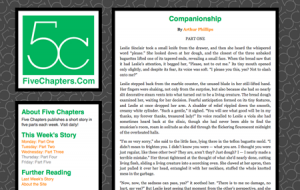
Screenshot of Five Chapters / image is from magneticstate.com
This being the 21st century, Twitter is a natural tool for serialization. In conjunction with Electric Literature, Rick Moody published a short story serialized into tweets, with one installment posted every 10 minutes. Reactions to the experiment were decidedly mixed, but its existence speaks to the renewed interest in the serialized fiction.
Meanwhile, online lit journal Five Chapters publishes a short story a week, with one part of the story issued each weekday. And Daily Lit allows subscribers to read variety of books–from Tom Sawyer to The Age of Innocence to The Best American Humorous Short Stories–in short installments emailed daily. Both are free.
For those who prefer paper to computer screen, author Nicholas Rombes is publishing his new novel Nightmare Trails at Knifepoint in serialized form… via snail mail. According to The Rumpus, the installments will be mailed from January 2010 to January 2011 and will be “stuffed into small manila envelopes, addressed by hand, with personal messages typed out on old hotel stationary and delivered right to your doorstep.” Rombes explains his rationale for the project thus:
As a lover of sequential, serialized narrative, I found that the most natural way to publish Ephraim’s strange odyssey was through a series of pamphlets, each one between 6 to 20 pages long, and each with a cliffhanger ending. […] I also loved the idea of telling his story in paper format, so that the story being told is more than the story itself, but also the medium of its publication. In other words, the pamphlets are worth keeping, featuring full-color covers and, sometimes, inserts.
Rombes’s website has more information about the novel and how to subscribe.
What makes the serialized form so attractive now? Is it an attempt to reclaim an older tradition? Is it a response to short communication forms like Twitter? And if you’ve read–or written–a serial novel or story, how was the experience different from a non-serialized one?


